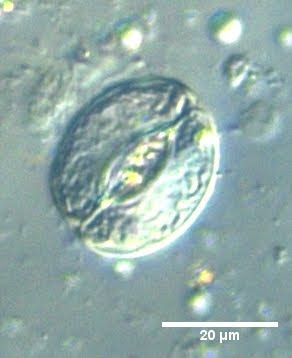Now I have rather limited experience working with gut endosymbionts (my second time), so I suck. Also, I didn't have the right solutions for keeping the denizens from exploding osmotically. So my images suck too. Kind of like this poor exploding trichonympha:

Actually, they seemed to be less exploded later when mounted in 5% glycerol (or perhaps they managed to die in the termite while I was working on the first sample, and experienced less osmotic shock that way somehow...) The glycerol may have helped out in the refractive index matching a bit, although perhaps I just magically came across better DIC settings later... (I need to stop speaking in strings of hypotheses. [fundie]I believe the glycerol helped my imaging, and I shall guard my faith until forever! Yeah, take that, 'evidence'! In other news, termite endosymbiosis is older than the earth itself. [/fundie])
First thing I saw was some mystery nematode: (was wiggling about way too much for a decent image) How do you key out nematodes anyway???


Top right: Some mystery...thing. Looks like an ex-organism, judging by the characteristic bubbles that tend to form when anaerobic protists die. Then again, those may well be artefacts of something else. Any ideas?
Bottom:Trichomitopsis! (it actually looks really cute when not completely mutilated)


(the scalebar on the second one is wrong; that would be about 12.5um, forgot to adjust for 40x settings...)
A slightly better shitty image of streblomastix; how many flagella can you count at the anterior end?

And fresh from the Crap on the Bottom of the Slide department, some mystery flagellates(?), or pieces of dirt sitting on top of bacteria (Or elongated pieces of crap). Hey, identifying whether crap is/was alive or not is kind of difficult sometimes! Although I'm pretty sure (B) is a real thing. (D) also looks kind of flagellated... any ideas?

Edit 18.08.09: With Opisthokont's help, possible IDs: A - hexamita?; B, E - monocercomonoides; C- a thing with an axostyle, or hexamita)
Then I had fun with the carnival ride that is a prism and and couple polarisers (aka DIC):
Trees in the autumn sky...

...roots on the autumn ground?

Shiny!

Omg, pseudo-darkfield! (no it's not)


The helical spiraly thing is a piece of xylem, methinks; termites eat wood right? Well, trichonympha eat wood inside the termite... so you get pieces of plant matter in them. And then you find random stomata floating about, which I'm pretty sure are not some weird contamination from my arabidopsis screening stuff (kinda reused the slide...)

Those things freaking haunt me, even when not doing research! Amazing how it survived intact...stomata can be quite fragile. Although perhaps that's specifically when you need them not to be...
Actually, wait, question: how the hell do stomata get in there if termites eat wood? While plants do have stomata on their stems, 1. termites don't munch on epidermal tissue all that muchl; 2. I doubt woody plants have any once bark is formed. Maybe it -is- some weird contamination from the previous sample...luckily, not actually doing any real science here.
Speaking of stomata, I has works to do. We're kind of like plant dentists - working on 'mouthes' all day! Especially with gene names like four lips(FLP), too many mouthes(TMM), speechless(SPCH), mute(MUTE), moustaches(MUS), etc. We also have YODA. Apparently somewhere in the Arabidopsis genome lies a regulatory gene SUPERMAN and its suppressor KRYPTONITE. We like to keep ourselves entertained...[/derail]
Let me know if you want more 'microforays'!

















Amazing to see that piece of xylem in the Trichonympha. It's always astounding to be confronted with visual proof of things you've only ever read about in the abstract. Like, of course termites eat wood, and so do their protist symbionts. And there's the xylem in its stomach! Duh!
ReplyDeleteXylem is gorgeous all on its own, too, thanks to all the thickenings, spirals, rings and openings. If you've never looked at a selection of tracheids under the microscope make sure you get the chance sometime.